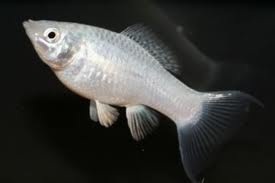
Silver Molly (Poecilia latipinna)
Overview: The Silver Molly has been selectively bred to produce a fish with a solid silver body and fins. There may be a bit of black flecking on the body. As a livebearer, the male will have a pointed shaped anal fin (gonopodium) while the female has a fan shaped anal fin
Native Range: North America
Max. Length: 3 inches
Water: 70°F to 79°F, pH: 7.0 to 8.5
Feeding: Omnivore
Behavior & Care: You can keep a single Molly, but they are more interesting when kept together since you can witness more of their natural behavior. Mollies will not form schools, but they do develop a strict hierarchy among themselves. The male Molly sporting the most striking colors and largest fins is the alpha Molly. If you keep only one male Molly and several females you will avoid a lot of fighting. |
|
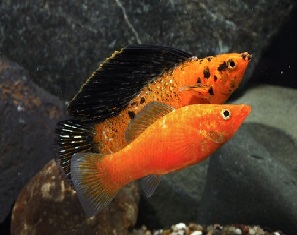
Sailfin Molly (Poecilia latipinna)
Overview: The sailfin molly is a species of fish, of the genus Poecilia. The body of the sailfin molly is essentially oblong. The head is small and dorsally flattened, with a small, upturned mouth. The caudal peduncle is broad and the caudal fin is large, rounded, and sometimes tipped with black.
Native Range: North Carolina to Texas and the Yucatán Peninsula of Mexico.
Max. Length: 5 inches
Water: 68 F to 75 F
Feeding: Omnivore
Behavior & Care: The Sailfin Molly requires a spacious aquarium to swim in with very little vegetation. It is usually advisable to keep one pair in each tank as males are more aggressive towards each other. |
|
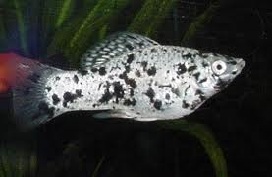
Dalmation Molly (Poecilia latipinna)
Overview: A medium-sized community tropical freshwater fish that eats flakes or blood worms. The fins are longer than normal mollies and most have a forked lyretail.
Native Range: Gulf of Mexico through the east coast of Florida to North Carolina
Max. Length: 4.5 inches
Water: 68-82°F; pH 7.0-7.8
Min. Tank Size: 20 gallons
Feeding: Omnivore
Behavior & Care: These fish are fine in community tanks as long as they are not overstocked with many other fish. This is a good fish for moderate skill. |
|
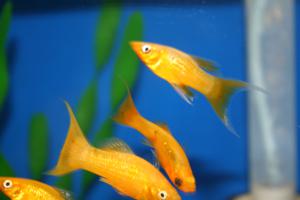
Lyretail Molly (Poecilia latipinna)
Overview: Mollies have the ability to adapt to a variety of salt levels in the aquarium. With a gradual acclimation, these fish may be maintained in either a freshwater or saltwater aquarium. In the freshwater aquarium, a teaspoon of aquarium salt per gallon is recommended for optimum health.
Native Range: Farm Raised, Singapore
Max. Length: 5 inches
Water: 68-82° F, KH 10-25, pH 7.0-7.8
Feeding: Omnivore
Behavior & Care: The Lyretail Molly is well suited for the community tank because of its peaceful nature, and is compatible with other peaceful, large fish that can withstand similar water conditions. |
|
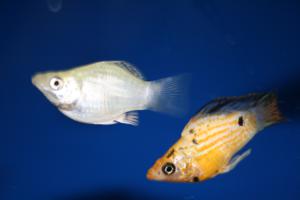
Balloon Molly (Poecilia latipinna)
Overview: The Balloon Molly is a hybrid variation of Poecilia latipinna ,the Sailfin Molly. The Balloon Molly has an arched back and a rounded, large belly. Color varieties include a combination of black, yellow, and white. These fish also have a large, lyre-shaped caudal fin and an impressive dorsal fin.
Native Range: East coast of Florida, Gulf of Mexico, North Carolina
Max. Length: 3 inches
Water: 68-82° F, KH 10-25, pH 7.0-7.8
Feeding: Omnivore
Behavior & Care: The Balloon Molly prefers a tank of at least 30 gallons with lots of strong plants such as Java fern, Sagittaria, Vallisneria and Anubias. They require a good filtration system because of their hearty appetites. The Balloon Molly is well suited for the community tank because of its peaceful nature, and is compatible with other peaceful, large fish that can withstand similar water conditions. They may pursue their young and the young of other fish. |
|
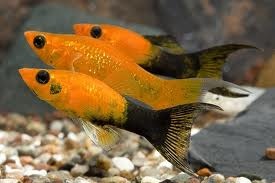
Gold Dust Molly (Poecilia sphenops (hybrid))
Overview: Gold Dust Molly has an interesting color scheme of black and gold that accentuates it's playful and energetic behavior. The colorful and lively Gold Dust Molly makes a peaceful addition to most aquariums.
Native range: Malaysia
Size: 3.5 inches
Water: 68-82° F pH 7.0-8.0
Feeding: Omnivore
Care: The Gold Dust Molly prefers hard, alkaline water conditions and may not thrive in aquariums with acidic or soft water. The Gold Dust Molly has the ability to adapt to a variety of salt levels in the aquarium. Through gradual acclimation, the Gold Dust Molly may be maintained in either a freshwater or saltwater aquarium. In the freshwater aquarium, a minimum of a teaspoon of aquarium salt per gallon is recommended for optimum health. |
|
| |







